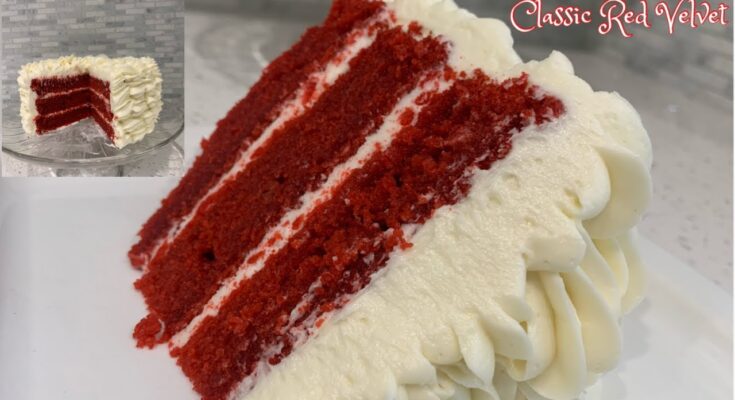Best Red Velvet Cake Recipe: If there’s one cake that knows how to steal the spotlight, it’s red velvet. With its vibrant red hue, tangy yet sweet flavor, and lusciously smooth cream cheese frosting, red velvet cake is a dessert that always brings the “wow” factor. But what really makes it so irresistible?
Red velvet cake isn’t just about the looks. Its taste is a unique blend—mild cocoa, a hint of vanilla, the tang of buttermilk, and that ever-so-slight acidic bite from vinegar. It’s not overpoweringly chocolaty like a chocolate cake, nor is it plain like vanilla cake. It lives in that perfect middle ground.
Historically, red velvet cake has roots going back to the early 20th century. Originally, the reaction between vinegar and natural cocoa powder gave the cake its reddish hue. Over time, food coloring took over to enhance the visual appeal. Today, it’s a staple in Southern baking and beloved all over the world for its festive appearance and indulgent taste.
So if you’ve ever wondered how to bake a moist, flavorful red velvet cake from scratch—look no further. This step-by-step guide will walk you through the process, from ingredients to frosting, helping you bake like a pro.
Ingredients You’ll Need
Let’s talk ingredients. Red velvet cake relies on a few key components that give it its signature texture and flavor. Here’s what you’ll need for the cake and the frosting:
Dry Ingredients:
- 2 ½ cups all-purpose flour
- 1 ½ cups granulated sugar
- 1 tsp baking soda
- 1 tsp salt
- 1 tbsp unsweetened cocoa powder
Wet Ingredients:
- 1 ½ cups vegetable oil
- 1 cup buttermilk, room temperature
- 2 large eggs, room temperature
- 1 tbsp red food coloring (gel or liquid)
- 1 tsp white vinegar
- 2 tsp pure vanilla extract
For the Frosting:
- 16 oz cream cheese, softened
- ½ cup unsalted butter, softened
- 4 cups powdered sugar
- 2 tsp vanilla extract
Optional Add-Ins:
- A pinch of espresso powder to enhance chocolate flavor
- A splash of almond extract for a deeper note
- Orange zest for a unique twist
Each ingredient plays a part in making the cake tender, flavorful, and unmistakably red velvet. Be sure to measure accurately and use fresh, quality ingredients for the best results.
Tools and Equipment Required
Before you dive into baking, it’s important to gather your tools. Having the right equipment makes the process smoother and more enjoyable.
Essential Baking Tools:
- Two 9-inch round cake pans
- Mixing bowls (one large, one medium)
- Electric hand mixer or stand mixer
- Rubber spatula
- Measuring cups and spoons
- Sifter or fine mesh sieve
- Cooling racks
Recommended Kitchen Gadgets:
- Offset spatula for frosting
- Cake leveler or serrated knife
- Parchment paper for lining pans
- Cake turntable (optional but helpful)
Having everything ready before you start mixing will make baking feel less like a chore and more like a creative ritual. Plus, it reduces the chances of missing an ingredient or step.
Step-by-Step Instructions
Let’s get baking! We’re breaking this down into clear, manageable steps. You’ll go from batter to beautiful red velvet cake with ease.
Step 1 – Preparing the Cake Pans
First things first—prepping your pans the right way can make or break your cake’s final texture. If the pans aren’t prepared properly, your cake might stick or bake unevenly.
- Preheat your oven to 350°F (175°C).
- Grease two 9-inch round cake pans with butter or non-stick spray.
- Line the bottoms with parchment paper for easy release.
- Lightly dust with flour to ensure nothing clings to the sides.
Doing this step well gives your cake layers a smooth finish and prevents crumbling when you remove them from the pans. Always prepare your pans before mixing the batter—once it’s ready, you’ll want to get it in the oven right away.
Step 2 – Mixing the Dry Ingredients
Now, onto the foundation of your cake—your dry mix.
- In a medium bowl, sift together:
- 2 ½ cups all-purpose flour
- 1 ½ cups sugar
- 1 tsp baking soda
- 1 tsp salt
- 1 tbsp cocoa powder
Sifting is essential here. It aerates the flour and ensures all dry ingredients are evenly distributed. Don’t skip this step—it makes your cake lighter and fluffier. Also, cocoa powder tends to clump, so sifting helps break those up and blend everything smoothly.
Once sifted, whisk the ingredients together to ensure an even mix. Set aside—this mix will be folded in with your wet ingredients shortly.
Step 3 – Creaming Butter and Sugar
This step builds the base for your cake’s moist, tender crumb. You want a light, fluffy mixture that helps create structure and adds a luxurious texture.
- In a large bowl, add 1 ½ cups of vegetable oil and 1 ½ cups granulated sugar.
- Beat on medium-high speed using a hand mixer or stand mixer for about 3–4 minutes.
- You’re looking for a pale, creamy consistency—not too runny, not too thick.
Vegetable oil is used instead of butter here, which keeps the cake super moist and gives it that velvety feel. While you can substitute with butter if you must, oil really shines in this recipe. The creaming process adds air, ensuring your cake isn’t dense. Don’t rush it. Let the mixer do its magic.
After the mixture is pale and fluffy, it’s ready for the eggs.
Step 4 – Adding Eggs and Wet Ingredients
Now it’s time to blend in the richness and tang that define red velvet cake.
- Add 2 large eggs, one at a time, beating well after each addition.
- Mix in 2 tsp of vanilla extract.
- Slowly pour in 1 cup of buttermilk while mixing on low speed. Do this in two parts.
- Mix just until combined—don’t overbeat.
Buttermilk is a game-changer. Its acidity helps tenderize the flour’s gluten, resulting in that soft, melt-in-your-mouth bite. And the eggs? They bring richness and structure, helping the cake hold together without being too dense.
Make sure everything is mixed evenly. Scrape down the sides of your bowl with a spatula to incorporate all ingredients properly. This step sets the stage for adding the color and vinegar.
Step 5 – Incorporating Dry Ingredients
Now that your wet base is ready, it’s time to bring in the dry mix.
- Gradually add the dry ingredients into the wet mixture in three parts.
- Mix on low speed after each addition just until the flour is absorbed.
- Scrape down the sides and bottom of the bowl after the final addition.
The goal here is to avoid overmixing. Overmixing can activate too much gluten in the flour, which makes cakes tough rather than tender. Just mix until there are no visible streaks of flour, and then stop.
You’ll notice the batter starting to thicken and come together—it should be velvety smooth by now, which is exactly what we’re going for.
Step 6 – Adding Food Coloring and Vinegar
Here comes the dramatic transformation—the deep red color and the final acid boost that ties the flavor together.
- In a small bowl, combine 1 tbsp red food coloring and 1 tsp white vinegar.
- Stir to blend, then pour into your cake batter.
- Mix gently with a spatula or mixer on low just until the color is fully incorporated.
The vinegar reacts with the baking soda, which helps the cake rise and gives it that slight tang we associate with red velvet. It also boosts the reddish tone of the cocoa powder—though the food coloring does the heavy lifting these days.
Choose gel food coloring if you want a more vibrant hue without thinning your batter. Liquid food coloring works too, but you may need a little more for the same effect.
Step 7 – Baking the Cake
You’re almost there! Let’s get this beauty in the oven.
- Divide the batter evenly between your two prepared cake pans.
- Smooth the tops with a spatula to ensure even layers.
- Place in the oven and bake at 350°F (175°C) for 30–35 minutes.
- Check for doneness by inserting a toothpick in the center. It should come out clean or with just a few crumbs.
Be careful not to overbake. Dry red velvet cake is a tragedy you don’t want to experience. If your oven has hot spots, rotate the pans halfway through baking for even cooking.
Once done, let the cakes cool in the pans for about 10 minutes. Then, run a knife around the edges, flip them onto a wire rack, and let them cool completely.
Step 8 – Cooling and Leveling the Layers
Now that your cakes are out of the oven and cooling, don’t rush to frost them just yet. Frosting a warm cake is like trying to ice a volcano—it’ll melt right off and turn into a sloppy mess.
- Allow the cakes to cool in the pans for 10 minutes.
- Carefully remove them and place on a wire rack to cool completely—at least 1 hour.
- Once fully cooled, use a serrated knife or a cake leveler to trim off the domed tops if needed.
Leveling the layers ensures your cake stacks evenly and looks polished. Don’t toss those cake tops though—they make perfect snacks or can be crumbled up for decoration later!
This cooling period also gives you time to whip up your cream cheese frosting, which we’re diving into next.
Making the Cream Cheese Frosting
The rich, tangy cream cheese frosting is the crown jewel of any red velvet cake. It’s creamy, it’s sweet, and it balances the cocoa notes beautifully. Let’s get it just right.
Ingredients You’ll Need:
- 16 oz cream cheese (room temperature)
- ½ cup unsalted butter (room temperature)
- 4 cups powdered sugar (sifted)
- 2 tsp pure vanilla extract
Whipping the Frosting:
- In a large mixing bowl, beat the softened cream cheese and butter together on medium-high speed until smooth—about 2–3 minutes.
- Add vanilla extract and mix for another 30 seconds.
- Gradually add sifted powdered sugar, 1 cup at a time, beating on low after each addition to avoid a sugar storm.
- Once all the sugar is added, beat the frosting on high speed for 2–3 more minutes until it’s fluffy and airy.
Pro Tips:
- Always use full-fat cream cheese for richness and structure.
- Don’t overbeat once it’s fluffy, or it may become too loose.
- If it’s too soft, chill it in the fridge for 15–20 minutes before spreading.
This frosting is decadent, smooth, and pipes like a dream. Taste it—you’ll probably have to resist eating it straight from the bowl.
Assembling and Frosting the Cake
Time for the fun part—putting it all together into a beautiful red velvet masterpiece.
- Place one cake layer on your serving plate or cake stand.
- Spread a generous layer of cream cheese frosting on top—use an offset spatula for best results.
- Place the second cake layer on top, leveled side down for a smooth top surface.
- Apply a thin “crumb coat” layer of frosting to seal in loose crumbs.
- Chill the cake for 15–20 minutes, then apply the final thick layer of frosting all over.
- Smooth out with a spatula or go rustic—it’s up to you!
Make sure to frost the sides evenly and add a swirl pattern on the top if you want that professional bakery look. Want extra drama? Use red velvet cake crumbs from your trimmings to decorate the sides or top. You can also add fresh berries or chocolate shavings.
Frosting a cake isn’t just decoration—it’s the glue that brings flavor and texture together. Take your time and enjoy the process!
Decoration Ideas
You can keep your red velvet cake classically elegant or go wild with creative designs. Here are some ideas:
Classic Look:
- Smooth white cream cheese frosting
- Red velvet crumbs pressed along the bottom edges
- A swirl design on top with a spoon or spatula
Creative Twists:
- Top with fresh strawberries, raspberries, or blueberries
- Add a drizzle of white chocolate ganache
- Pipe decorative rosettes with a star tip
- Dust the top lightly with cocoa powder or edible gold
No matter which route you go, this cake will turn heads and taste incredible. Don’t be afraid to show off your personality through your decorations!
Storage and Shelf Life
So, you’ve baked and decorated your stunning red velvet cake—what now? Whether you’re saving leftovers or prepping ahead, proper storage is key to keeping it fresh and delicious.
At Room Temperature:
- If your home is cool and the cake is well covered, it can sit out for up to 2 days.
- Use a cake dome or cover with plastic wrap to prevent drying.
In the Refrigerator:
- For longer storage, refrigerate the cake. It will stay fresh for up to 5 days.
- Store in an airtight container or wrap it tightly in plastic wrap.
- Before serving, bring it to room temperature for about 30 minutes to allow the frosting to soften.
Freezing the Cake:
- Red velvet cake freezes beautifully.
- Wrap individual slices or whole unfrosted cake layers in plastic wrap and then foil.
- Freeze for up to 2 months.
- To thaw, move it to the fridge overnight and bring to room temperature before frosting or serving.
A well-stored red velvet cake retains its moisture and flavor, so don’t worry if you can’t finish it all at once. It makes a fantastic treat any day of the week!
FAQs about Red Velvet Cake Recipe
1. Can I make red velvet cake without food coloring?
Yes, you can. The cake will have a more natural reddish-brown tone from the cocoa powder, especially if you use natural (non-Dutch-processed) cocoa. Beetroot powder is also a great natural alternative to food coloring.
2. What’s the best substitute for buttermilk?
If you don’t have buttermilk, mix 1 tablespoon of white vinegar or lemon juice with 1 cup of milk. Let it sit for 5–10 minutes, and you’ve got an easy buttermilk substitute.
3. How do I make this cake gluten-free?
Use a 1:1 gluten-free flour blend that includes xanthan gum. Red velvet cake is pretty forgiving, so gluten-free substitutions usually work well.
4. Can I freeze red velvet cake layers?
Absolutely. Wrap cooled, unfrosted layers tightly in plastic wrap and foil. Freeze for up to 2 months. When ready, thaw in the fridge overnight and frost as usual.
5. How long can red velvet cake sit out?
If it’s cool and covered, red velvet cake can sit out at room temperature for about 2 days. Any longer, and you’ll want to refrigerate it to keep the cream cheese frosting safe and the cake moist.
Conclusion
There you have it—the ultimate, step-by-step guide to making the best red velvet cake from scratch. From the perfectly balanced flavor to the luscious cream cheese frosting, this cake is guaranteed to impress at birthdays, holidays, or just because.
Red velvet isn’t just a cake—it’s an experience. It’s the kind of dessert that turns any ordinary day into something a little more special. Whether you’re a seasoned baker or trying your hand for the first time, this recipe gives you all the tools to succeed.
So put on your apron, crank up your favorite music, and get ready to whip up a show-stopping dessert that’s as gorgeous as it is delicious. Happy baking!



